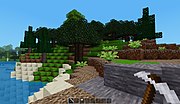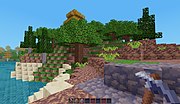 Comment: The deleting admins of the draft include Mr. Stradivarius, Mark Arsten, and ReaderofthePack. I dream of horses (Contribs) Please notify me after replying off my talk page. Thank you. 21:31, 1 December 2020 (UTC)
Comment: The deleting admins of the draft include Mr. Stradivarius, Mark Arsten, and ReaderofthePack. I dream of horses (Contribs) Please notify me after replying off my talk page. Thank you. 21:31, 1 December 2020 (UTC)
 Comment: As a parent of a child being introduced to the subject of this article, I'm glad I was able to find this article, and am surprised it's only a draft. It exceeds the standards of many other wikipedia articles and is an example of uneven scrutiny some subjects receive. IMO, footnotes 10 and 11 should themselves be sufficient for notability, although anyone with kids would find it notable enough just by virtue of it being a minecraft alternative independent of some large corporation that might be data-mining my son's every move. 70.19.86.82 (talk) 16:38, 24 November 2020 (UTC)
Comment: As a parent of a child being introduced to the subject of this article, I'm glad I was able to find this article, and am surprised it's only a draft. It exceeds the standards of many other wikipedia articles and is an example of uneven scrutiny some subjects receive. IMO, footnotes 10 and 11 should themselves be sufficient for notability, although anyone with kids would find it notable enough just by virtue of it being a minecraft alternative independent of some large corporation that might be data-mining my son's every move. 70.19.86.82 (talk) 16:38, 24 November 2020 (UTC)
 Comment: I discussed this article at #wikipedia-en-help, and +LittleBlueBori suggested the following changes to address low quality sources: removing all references for project website, wikis, code repos, home pages. I really hope we can get this article improved enough to make it worthy of Wikipedia. SoylentCow (talk) 19:15, 26 August 2020 (UTC)
Comment: I discussed this article at #wikipedia-en-help, and +LittleBlueBori suggested the following changes to address low quality sources: removing all references for project website, wikis, code repos, home pages. I really hope we can get this article improved enough to make it worthy of Wikipedia. SoylentCow (talk) 19:15, 26 August 2020 (UTC)
 Comment: Continues to fail WP:GNG, nothing has changed since the article was AfD'd. While the article seems notable on the surface, most of the sources are unreliable. It is mentioned in a few papers, but I don't see the typical indications of notability like reviews or significant critical commentary. ZXCVBNM (TALK) 06:15, 8 August 2020 (UTC)
Comment: Continues to fail WP:GNG, nothing has changed since the article was AfD'd. While the article seems notable on the surface, most of the sources are unreliable. It is mentioned in a few papers, but I don't see the typical indications of notability like reviews or significant critical commentary. ZXCVBNM (TALK) 06:15, 8 August 2020 (UTC)
 Comment: Note that an article on Minetest was previously deleted at Wikipedia:Articles for deletion/Minetest, so any submission will need to address the reasons for its deletion. Jackmcbarn (talk) 04:13, 7 August 2020 (UTC)
Comment: Note that an article on Minetest was previously deleted at Wikipedia:Articles for deletion/Minetest, so any submission will need to address the reasons for its deletion. Jackmcbarn (talk) 04:13, 7 August 2020 (UTC)
 | |
| Original author(s) | Perttu Ahola |
|---|---|
| Developer(s) | Minetest team |
| Initial release | 0.0.1 / November 2, 2010 |
| Stable release | 5.3.0
/ July 9, 2020 |
| Repository | github |
| Written in | C++, Lua |
| Engine | Irrlicht |
| Platform | Linux, FreeBSD, Microsoft Windows, MacOS, Android |
| Type | Sandbox, Survival |
| License | GNU Lesser General Public License v2.1 |
| Website | https://www.minetest.net/ |
Minetest is a free and open-source sandbox video game developed by a team of volunteers, with significant contributions from the community.[1] The first publicly available version was Minetest 0.0.1, created by Perttu Ahola, and released on the Web in November 2010. Minetest is programmed in C++ using the Irrlicht Engine, and is available for Linux-based systems, FreeBSD, Microsoft Windows, MacOS, and Android. Minetest provides an API for users to create their own games and mods written in Lua.
In Minetest, players explore a blocky, procedurally-generated 3D world with seemingly infinite terrain, and may discover and extract raw materials, craft tools and items, and build structures and landscapes. Depending on game mode and mods present, players can fight computer-controlled "mobs", as well as cooperate with or compete against other players in the same world.
The game mechanics of Minetest are similar to those of a 2009 game Minecraft,[2] though the original author stopped just short of describing it as a "Minecraft clone". Over a decade of active development Minetest has garnered critical acclaim and gained in popularity; since November 2013 Minetest has been downloaded over 1.4 million times from GitHub, and the Android version of Minetest has over 500 thousand downloads on the Google Play store. Minetest has also been used in school education to teach abstract thinking and as an interactive visualization tool. Minetest is free software since November 29, 2010, allowing users to study and modify both the source code and the included art.
Gameplay

Minetest is a voxel sandbox video game that has no specific goals to accomplish, allowing players a large amount of freedom in choosing how to play the game. Gameplay is in the first-person perspective by default, but players have the option for third-person perspective. The game world is composed of voxels: 3D objects, many of them simple cubes, commonly called "nodes". Different voxels represent various materials, such as dirt, stone, ores, tree trunks, water, and lava. The core gameplay revolves around picking up and placing these objects, one node at a time. Nodes are arranged in a 3D grid, while players can move smoothly around the world. Players can "mine" (or "dig") blocks and then "place" (or "build") them elsewhere, enabling them to modify the game world. Players can also craft a wide variety of hand-held tools to aid them with the world modification. Pick axes allow to dig rocky nodes, shovels speed up the digging of dirt and sand, water buckets allow to pick up water nodes, etc. A player controls a 3D character known as Sam, which is a recursive acronym for "Sam ain't Minecraft".
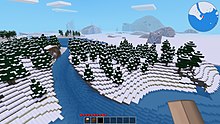
The game world is very large and appears to be infinite for many practical purposes. As players explore the world, new areas are procedurally generated, using a map seed specified by the player. A new game puts the player in the center of a voxel cube 62 thousand nodes across, so the player can travel 31 thousand nodes in any direction (sideways, up, or down) before reaching the invisible wall at the end of the world. Storing the entire voxel array of that size would require hundreds of terabytes of memory, but the game sidesteps this requirement by splitting the world data into smaller 16x16x16 sections called "map blocks" that are only created or loaded when players are nearby.
The world is divided into biomes ranging from deserts to jungles to snowfields; the terrain includes plains, mountains, forests, caves, and various lava/water bodies. The in-game time system follows a day and night cycle, and one full cycle lasts 20 real-time minutes.
Minetest provides two basic game mode options: Enable Damage and Creative Mode which affect how players interact with the world and use items. Creative Mode is intended to provide players with infinite resources, while toggling the damage setting determines whether the players are able to take damage from environmental hazards and other players.
Multiplayer
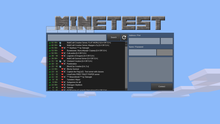
Minetest implements a client-server architecture, and can be played solo or with other people over the Internet. A player starting a new game can choose between playing in a single-player mode, or hosting a server to which other Minetest clients can connect. For hosted games, there is an option to announce them at the public server list. Alternatively, a player can browse the public server list and connect to one of the Internet servers.
Many Minetest servers are run by volunteers who are not affiliated with the Minetest project, and feature wildly different rules, options, and modifications, with game modes that can be described as cooperative voxel art, player-versus-player survival, capture the flag, etc.
Customizations
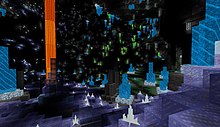
The full source code of Minetest, and all of its artistic assets such as textures and sounds, are distributed under a variety of free licenses, making it easier to create modified versions and derivatives. The base version of the Minetest provides an interface for games and mods written in Lua. Games define the basic rules of the game world, and are a core feature of Minetest. Most games feature a sandbox gameplay focused on construction, mining, and creativity. Mods are used to further customize various aspects of gameplay, and are an inherent part of Minetest. Mods are server-side and work out of the box when playing on Internet servers, with no manual installation required. Players can also download texture packs to change the appearance of nodes.
Games
Developers refer to Minetest as an engine rather than a "game" because almost every aspect of gameplay is implemented within so-called games written in Lua. Since version 5.0.0, the main menu of the Minetest engine allows users to browse and install games from a curated list.
Minetest is shipped with two games: Minetest Game implementing a feature-rich sandbox, and Development Test implementing a minimal sandbox useful for debugging. Minetest Game implements a simple and peaceful game with no goals and no built-in computer enemies. It features over 200 node types and a variety of digging tools, trees, flowers, ores, biomes, and underground caves.
Mods
There are over 1000 free and open-source mods available at Minetest forums. Since version 5.0.0, Minetest features a built-in content picker, allowing users to browse a curated list of add-ons and install mods and texture packs with a single click. Mods can be used to add node types, tools, monsters, player skins, and alter many aspects of the gameplay. Both the forums and the in-game browser exclude non-free and closed source software as a matter of policy.
Development

By agreement among major contributors, in June 2012 the project license was changed to LGPLv2.1/later, with small parts still remaining under GPLv2/later. While LGPLv2.1/later remains the main license for the Minetest engine, other free and open-source licenses are used for various other parts of the latest release.
Perttu Ahola was the only developer working on the project for about six months, until Ciaran Gultnieks started making code contributions in May 2011.[1] The roster of contributors grew and changed over the years. As of July 2020, there are 9 active core developers and 15 active contributors. Core developer is considered primarily a position of trust, and they are the ones deciding what is merged into the upstream repositories, and do not necessarily contribute the most by volume. Project participants do not have set roles, but rather keep their activity within their respective areas of expertise. Perttu Ahola's role morphed over the years: whereas initially it was engine development, now it is mostly Web-hosting and administration, assigning core developer, moderator, and other roles to people, as well as being the final word in cases where other developers are unable to render a decision.[1]
Usage in education
Minetest has been used in educational environments to teach subjects such as mathematics, programming, and earth sciences. Its advantages over similar commercial titles include zero cost, allowing for massive deployments in a classroom or a research setting. Also, Minetest's graphics engine, while not fully optimized for the most recent hardware, performs very well on a wide range of low-cost, low-end hardware.[1]
- Minetest was used as a co-design tool for teaching children who can not attend in person sessions.[3]
- Minetest was used for teaching logic, creating, and debugging to primary and secondary students.[4]
- In 2017 in France, Minetest was used to teach calculus and trigonometry.[5]
- At Federal University of Santa Catarina in Brazil, Minetest was used to teach programming in a variant called MineScratch.[6]
- In 2018, for Laboratory Education and Apprenticeships (EDA) at the Paris Descartes University, Minetest was used to teach life and earth sciences to year 6 students who could not observe some phenomena in person but could experience them in the Minetest virtual world.[7]
Reception
Opensource.com listed Minetest at #1 in its "Best open source games of 2015",[8] stating that it is maybe "the most complete alternative to Minecraft", and noted its expansibility, stating that it contains a user-friendly API for creating mods in Lua.[9] PC Magazine listed Minetest among "The best Sandbox Creation Games for Minecraft Fans".[10]
See also
References
- ^ a b c d "Open source game developer Perttu Ahola talks about Minetest with Wikinews". Wikinews. June 30, 2020. Archived from the original on July 12, 2020. Retrieved July 11, 2020.
- ^ Saunders, Mike (November 2017). "Minetest". Linux Magazine (204/2017). Archived from the original on February 3, 2021. Retrieved July 30, 2020.
- ^ Walsh, Greg; Donahue, Craig; Rhodes, Emily E. (2015). "KidCraft: Co-Designing within a Game Environment" (PDF). Archived (PDF) from the original on February 3, 2021. Retrieved October 12, 2019.
- ^ "Evaluation of existing resources (study/analysis)" (PDF). TACCLE 3 – Coding. October 24, 2016. Archived (PDF) from the original on May 16, 2018. Retrieved February 16, 2019.
- ^ Boutet, Henri. (January 2017). "Mathématiques et "serious gaming": l'exemple de Minetest" [Mathematics and "serious gaming": the example of Minetest]. Mathématice. Num. 53 (in French). Archived from the original on June 29, 2019. Retrieved October 12, 2019.
- ^ da, Rocha, Jhonata (November 23, 2016). "MineScratch: integração minetest-scratch para apoiar o ensino de programação" [MineScratch: Minetest-Scratch Integration to Support Programming Teaching]. Repositório Institucional da UFSC (in Brazilian Portuguese). Archived from the original on February 3, 2021. Retrieved February 16, 2019.
((cite journal)): CS1 maint: multiple names: authors list (link) - ^ Pauty-Combemorel C. (February 7, 2018). "Utilisation d'un jeu vidéo dans le cadre de l'enseignement des SVT: le cas de Minetest. De 0 à 1 ou l'heure de l'informatique à l'école" [Using a video game as part of the teaching of Life and Earth Sciences: the case of Minetest. From 0 to 1 or computer time at school.] (in French). Archived from the original on October 11, 2019. Retrieved October 11, 2019.
- ^ Muilwijk, Robin (December 30, 2015). "Best open source games of 2015". Opensource.com. Archived from the original on May 1, 2019. Retrieved February 16, 2019.
- ^ Baker, Jason (October 12, 2017). "10 open source alternatives to Minecraft". Opensource.com. Archived from the original on October 30, 2019. Retrieved October 12, 2019.
- ^ Cohen, Jason (August 28, 2019). "The Best Sandbox Creation Games for Minecraft Fans". Archived from the original on December 17, 2019. Retrieved December 17, 2019.
((cite journal)): Cite journal requires|journal=(help)
| General | |||
|---|---|---|---|
| Software packages | |||
| Community | |||
| Organisations | |||
| Licenses |
| ||
| Challenges | |||
| Related topics | |||
